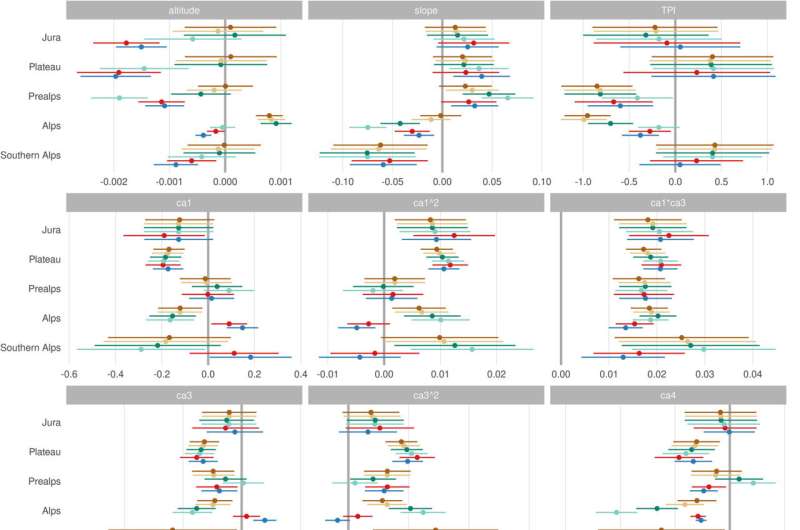This article has been reviewed according to Science X's editorial process and policies. Editors have highlighted the following attributes while ensuring the content's credibility:
fact-checked
trusted source
proofread
Woodland versus wind turbine: Identifying drivers of forest clearances in Switzerland

Special permission is required to clear forest in Switzerland. Until now, the system has worked well. However, plans to increase wind and solar electricity generation could increase conflicts.
Around 185 hectares of forest—equivalent to 260 football pitches—are cleared in Switzerland each year. This is not due to felling or storm damage, but to create space for roads, mobile phone masts, drinking water catchment installations, gravel pits and other infrastructure. And even more forest is expected to be sacrificed as renewable energy sources such as wind and solar farms continue to grow, even though it is in principle necessary to compensate for lost woodland.
In Switzerland, forest land may not be cleared for infrastructure without a permit, and meticulous records are kept. "Every single project from the last 120 years has been recorded," explains agricultural economist David Troxler. "This data collection is unique in the world and has barely been used for research up to now." Until now, research into forest clearance has focused primarily on the tropics and developing countries.
As part of the National Research Programme "Sustainable Economy" (NRP 73), the ETH Ph.D. student has analyzed the digitalized data sets for 2001 to 2017, which comprised over 6,000 projects. He combed the data for links between the reasons for forest clearances and factors such as landscape and population density. His aim was to gain a better understanding of the driving forces and highlight solutions to potential conflicts.
By and large, the Swiss forestry protection system is currently working well, Troxler says. For example, forest clearance is not more common in intensively farmed areas than anywhere else.
"It's not like the tropics, where forests with good access are sacrificed to make space for new crops." Furthermore, he found no evidence of particularly heavy forest clearances for new ski lifts or similar infrastructure in Alpine tourist areas. He interprets the lack of such typical patterns as a sign that the control mechanisms are working. In the Alps, there is even an increase in forestation as a growing number of alpine meadows are being returned to nature.
Virtually no space in the Mittelland
Losses in terms of existing forest area were greatest in the Mittelland (Swiss Plateau), with temporary or permanent clearance affecting around 0.5 percent of forested areas between 2001 and 2017. This reflects the fact that conflicting demands are most pronounced in this heavily populated area.
"It's a region where forests are exposed to a particularly high number of converging needs," Troxler explains. While local populations see the forests as an important recreational space and precious ecosystem, people also want more living space and good transport links. The Mittelland is also an attractive region for commercial forestry since it is flat and served by a good transport network.
It is therefore increasingly difficult to find space for the reforestation required by law to compensate for clearances. Farmers are unwilling to give up a single square meter of ever-dwindling farmland, and no one wants to rezone building land as a non-building zone.
"Since it is increasingly difficult to find reforestation space, it will become increasingly necessary to make use of the exemption rules that already exist," Troxler explains. Among other things, these provide for an ecological upgrading of existing forest instead of planting new forest. Troxler is currently ascertaining how often these exemptions are applied.
As regards the immediate future, Troxler expects conflicting demands to increase. This is because the expansion of renewable energy sources will also come at the cost of forested land, particularly in the Alps and Mittelland, even though the wide range of projects makes it difficult to quantify how much space will be needed.
Space will not only have to be created for the wind turbines and solar panels themselves, but also for the associated high-voltage lines, construction site access roads and dams. "And this infrastructure forms part of a sustainable economy that is actually socially desirable." This dichotomy is already apparent in legal rulings. Since 2017, forest conservation has no longer had a higher legal status than the construction of infrastructure for renewable energy.
To minimize conflicts going forward, Troxler advises proactive planning on the part of the authorities to secure space for like-for-like reforestation at an early stage—for example by creating interregional land pools. "The cantons should already have ideas up their sleeve to prevent forest conservation requirements being further eroded."
The findings are published in the journal Forest Policy and Economics.
More information: David Troxler et al, Identifying drivers of forest clearances in Switzerland, Forest Policy and Economics (2023). DOI: 10.1016/j.forpol.2023.102938
Provided by Swiss National Science Foundation





















